
Twenty-two years ago, a group of French government agents blew up a ship known as the Rainbow Warrior off the coast of New Zealand. On board were activists from the group Greenpeace who were protesting French nuclear testing in the Pacific. One member of Greenpeace died in the blast. Thirteen French agents were identified as being directly involved in the bombing but only two were ever convicted. Now it has been revealed that the commander of the unit is living freely in McLean, Virginia. Louis-Pierre Dillais is president of an arms manufacturer with several government contracts. Greenpeace has urged the Department of Homeland Security to deport Dillais became of his direct ties to an act of state terrorism. But the Bush administration has not moved on the request. We speak with Greenpeace attorney Deepa Isac. [includes rush transcript]
Transcript
JUAN GONZALEZ: We go now from terror in the skies to a story about terror in the seas. Twenty-two years ago, a group of French government agents blew up a ship known as the Rainbow Warrior off the coast of New Zealand. On board were activists from the group Greenpeace, who were protesting French nuclear testing in the Pacific. One member of Greenpeace, Fernando Pereira, died in the blast. Thirteen French agents were identified as being directly involved in the bombing, but only two were ever convicted. Now it has been revealed that the commander of the French unit is living freely in McLean, Virginia.
AMY GOODMAN: His name is Louis-Pierre Dillais. He is the president of the arms manufacturer FNH USA, a company that has government contracts with the Department of Homeland Security, Secret Service and the Department of Defense. Greenpeace has urged the Department of Homeland Security to [deport] Dillais — by the way, his name is spelled D-I-L-L-A-I-S — to deport Dillais because of his direct ties to an act of state terrorism. But the Bush administration has not moved on the request. We left a message at Dillais’s office in McLean, but didn’t hear back from him. In 2005, he admitted to being involved in the bombing. During an interview with a journalist from New Zealand, he said, “I did not know I would be involved in the operation to kill anyone, but when you are in the military you obey your orders.”
To talk more about the case, Deepa Isac joins us in Washington. She is a staff attorney for Greenpeace. Welcome to Democracy Now!
DEEPA ISAC: Thank you.
AMY GOODMAN: Explain exactly what Dillais’s involvement was and what happened that day in the Auckland Harbour in New Zealand in 1985?
DEEPA ISAC: Well, Dillais was the mission commander of the operation, and the French themselves termed the operation “Operation Satanic.” And for this, he was the mission commander, and as part of that, he organized the operation and he also drove the inflatable boat, which dropped off two people that planted the bombs on the bottom of the Rainbow Warrior.
AMY GOODMAN: How do you know this?
DEEPA ISAC: Huge amounts of investigation happened. After the bombing itself, the New Zealand authorities looked into this information. There was a great deal of investigation that happened. Recently, New Zealand documentaries also have investigated the matter, and they identified approximately 13 people who were agents during this event, and he is one of those people.
JUAN GONZALEZ: And why were only two arrested and convicted, if there were so many involved?
DEEPA ISAC: Well, this is a very complicated issue, because it’s a state-sponsored terrorist event. So, because of that, there were a lot of negotiations that were going on between France and New Zealand, New Zealand being where the bombing itself took place. So there were a variety of different things. People in this operation were also related to people within the administration in France at the time. There’s a lot of different intervening factors. I don’t think there was a very specific methodical justice process that happened.
JUAN GONZALEZ: And how did you learn that he was living here in the United States?
DEEPA ISAC: We learned about this from those New Zealand journalists, themselves, when they were doing the documentary.
AMY GOODMAN: Ken Silverstein has an interesting piece on the website of Harper’s : “Alleged Plotter in Rainbow Warrior Bombing Selling Weapons to the U.S. Government.” Can you explain, Deepa Isac, exactly what FNH USA is, the company that Louis-Pierre Dillais is involved with, heads up, here in the United States, and his direct relationship with the U.S. government?
DEEPA ISAC: He’s actually the president of FNH USA. FNH USA is the U.S. subsidiary of a Belgian corporation, and they’re specifically arms dealers. They sell arms to the United States government through Homeland Security, through the Department of Defense, through various police departments, even, in the United States. And he is the president of that organization, and he has direct contracts with the United States government.
JUAN GONZALEZ: So, in essence, as I understand it, one of the contracts with the Pentagon is to outfit special operations units with weapons and that they’re supposed to be involved in the fight against terrorism?
DEEPA ISAC: Yes, that’s exactly it. The weapons that are being sold from FNH USA are being used by the Bush administration’s war on terror. I mean, it’s, you know, a very clearly ironic situation that they are buying arms from someone who has acknowledged that he was involved in terrorist activities and the murder of at least one person.
AMY GOODMAN: I’m looking at both your letter, Greenpeace’s letter, to the assistant secretary, Julie Myers, of Homeland Security, calling for the deportation and detention of Dillais, as well as their response. November 9, 2006, William Howard, principal legal adviser for U.S. Immigration and Customs Enforcement, ICE, said they have forwarded your letter for appropriate action.
You have written in your letter, “Addressing a joint session of Congress nine days after the horrific attacks of September 11, 2001, President Bush declared 'from this day forward, any nation that continues to harbor or support terrorism will be regarded by the United States as a hostile regime.'” And you write, “Right now, a man who has confessed to his role directing in an act of state terrorism, a man who confessed to New Zealand television his role in sabotage, bombing and murder, lives among us. In the name of security and antiterrorism measures, this administration has repeatedly restricted the rights of individuals and organizations such as Greenpeace to conduct legitimate and peaceful protest. It would be hypocrisy of the highest order if, while maintaining such restrictions, it took no action against Louis-Pierre Dillais, who has engaged in sabotage by participating in and planning the bombing of the Rainbow Warrior. We respectfully request the deportation of Mr. Dillais as an undesirable alien on the basis of his previous act of terrorism.”
Why just his deportation? If he is a terrorist living freely in the United States, why aren’t you calling for him to be charged and tried?
DEEPA ISAC: Well, that is a decision for governments to make. Specifically, this letter was addressed to the United States government, so we’re asking them to bring him to justice. Whether that’s in the form of deportation, I — you know, getting rid of these contracts, not doing work with a terrorist, that would also be an issue for New Zealand, that’s an issue for France, that’s an issue for the Netherlands, where Mr. Pereira, our photographer who was killed, is a citizen of.
We acknowledge and recognize that this incident was 22 years ago, that this terrorist event was back then. However, to us, right now the importance isn’t a vendetta specifically against Mr. Dillais; rather, we want to make sure that the United States government isn’t harboring a known terrorist, someone who has acknowledged their role in terrorist activities. You know, we don’t want the United States to be buying arms from a terrorist.
And part of the issue with all of this is that there is selective prosecution going on. You know, as we mention in our letter to the U.S. government, the Bush administration has, in the name of security and antiterrorism, they’ve restricted the rights of people in this country, including Greenpeace, for that matter. You know, we’ve openly acknowledged from our inception that we are strictly a peaceful, nonviolent organization that engages in political speech. Meanwhile, we have been prosecuted, we’ve been investigated, we’ve had countless dollars spent on us by the FBI investigating our activities, and yet they’re spending thousands, millions of dollars in arms contracts with a terrorist. So a big part of this is wanting the U.S. government to acknowledge and then reverse this trend of selective prosecution.
JUAN GONZALEZ: And could you remind us in the little time we have left of what was the Rainbow Warrior doing at the time it was bombed by these French agents?
DEEPA ISAC: At the time, Greenpeace, as its history also, was rescuing people from the island of Rongalap who had asked that we rescue them and evacuate them from their island and relocate them to another island. They had had years of radiation coming on down to them from the United States bombing that area through nuclear testing. They would be setting off nuclear bombs for testing, bombs that are larger than Hiroshima, and that had devastating impacts on the villages there, suffering from radiation sickness, thyroid cancer, genetic disorders, miscarriages in the children. So we had first done that, and then they had spent a few days in the Auckland Harbour in New Zealand on their way to Mururoa in the French Polynesian islands to protest their nuclear testing there.
AMY GOODMAN: Deepa Isac, we want to thank you very much for being with us, staff attorney at Greenpeace.
DEEPA ISAC: Thank you.
AMY GOODMAN: And this interesting note, last year the New Zealand papers reported that the brother of the French presidential candidate Segolene Royal was also involved in the bombing of the Rainbow Warrior. Gerard Royal was reportedly the agent who attached the bomb to the hull of the ship, this according to another of their brothers, Antoine Royal, in an interview.

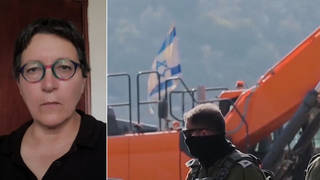
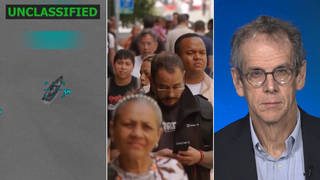
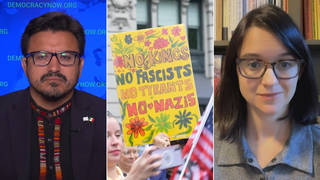
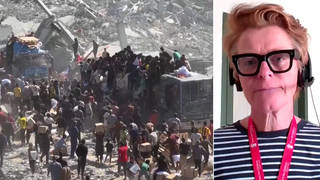






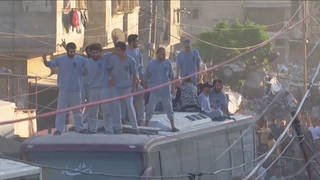
Media Options